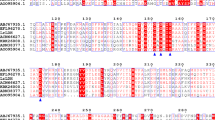Summary
Production, purification and characterization of the NAD(H)-dependent d-mandelate dehydrogenase from Lactobacillus curvatus was studied. An enzyme level of about 150 U/1 could be obtained by anaerobic cultivation in liquid broth. The specific enzyme activity in the crude extract was 1—3 U/mg. Purification by liquidliquid extraction and ion exchange chromatography led to a preparation of 2100 U/mg. The molecular weight of the enzyme was determined to be 60000 (gel filtration on Superose S12) containing two subunits of 30000. A variety of aliphatic and aromatic α-keto acids are accepted as substrates by the mandelate dehydrogenase, for the substrate benzoylformate a Michaelis constant of 2·10-4M was measured. Cu2+-ions and mercury compounds such as HgCl2 or p-chloromercuribenzoate are strong inhibitors at concentrations of 0.1 mM. An unoptimized continuous conversion in an enzyme-membrane-reactor demonstrated that the enzyme could be applied for the stereospecific synthesis of d-mandelic acid.
Similar content being viewed by others
Abbreviations
- FDH:
-
formate dehydrogenase
- PEG:
-
polyethylenglycol
- SDS:
-
sodiumdodecylsulfate
- MRS:
-
growth medium according to deMan, Rogosa and Sharpe (deMan et al. 1960)
References
Bückmann AF, Kula M-R, Whichmann R, Wandrey C (1981) An efficient synthesis of high molecular weight NAD(H)-derivatives suitable for contnuous operation with coenzyme depending enzyme systems. J Appl Biochem 3:301–315
Bradford MM (1976) A rapid and sensitive method for the quantitation of microgram quantities of protein utilizing the principle of protein-dye binding. Anal Biochem 72:248–254
Cordes A, Kula M-R (1986) Process design for large-scale purification of formate dehydrogenase from Candida boidinii by affinity partition. J Chromatogr 376:375–384
Hummel W, schütte H, Kula M-R (1983) Large scale production of d-lactate dehydrogenase for the stereospecific reduction of pyruvate and phenylpyruvate. Eur J Appl Microbiol Biotechnol 18:75–85
Hummel W, schütte H, Kula M-R (1985a) d-2-Hydroxyisocaproate dehydrogenase from Lactobacillus casei. A new enzyme suitable for stereospecific reduction of 2-ketocarboxylic acids. Appl Microbiol Biotechnol 21:7–15
Hummel W, Schütte H, Leuchtenberger W, Kula M-R (1985b) Mikrobiologisch hergestellte d(-)-Mandelat-Dehydrogenase, Verfahren zu ihrer Gewinnung und ihre Verwendung. German application DP 35 36 662.1
Hummel W, Schmidt E, Wandrey C, Kula M-R (1986) l_Phenylalanine Dehydrogenase from Brevibacterium sp. for production of l-phenylalanine by reductive amination of phenylpyruvate. Appl Microbiol Biotechnol 25:175–185
Hummel W, Schütte H, Schmidt E, Wandrey C, Kula M-R (1987) Isolation of l-phenylalanine dehydrogenase from Rhodococcus sp. M4 and its application for the production of l-phenylalanine. Appl Microbiol Biotechnol 26:409–416
Jovin T, Chrambach A, Maughton MA (1964) An apparatus for preparative temperature-regulated polyacrylamide gel electrophoresis. Anal Biochem 9:351–369
Kula M-R, Kroner KH, Hustedt H (1982) Purification of enzymes by liquid-liquid extraction. Adv Biochem Eng 24:73–118
deMan JC, Rogosa M, Sharpe ME (1960) A medium for the cultivation of Lactobacilli. J Appl Bacteriol 23:130–135
Mori K, Akao H (1980) Synthesis of opticallyactive alkynyl alcohols and α-hydroxyesters by microbial asymmetric hydrolysis of the corresponding acetates. Tetrahedron 36:91–96
Schütte H, Hummel W, Kula M-R (1984) l-2-Hydroxyisocaproate dehydrogenase — A new enzyme from Lactobacillus confusus for the stereospecific reduction of 2-ketocarboxylic acids. Eur J Appl Microbiol Biotechnol 19:167–176
Shapiro AL, Vinuela E, Maizel JV (1967) Molecular weight estimation of polypeptide chains by electrophoresis in SDS-polyacrylamide gels. Biochem Biophys Res Commun 28:815–820
Wandrey C (1986) Synthesis of l-amino acids by isolated enzymes and microorganisms. In: Schneider MP (ed) Enzymes as catalysts in organic synthesis, D. Reidel Publishing company, pp 263–284
Wandrey C, Bossow B (1986) Continuous cofactor regeneration — utilization of polymer bound NAD(H) for the production of optically active acids. Biotechnol Bioindustry 3:8–13
Wandrey C, Wichmann R, Kula M-R, Bückmann AF (1984) Enzym-Membran-Reaktor, Technologietransfer: Beispiel Produktion von l-Aminosäuren. Die Umschau 3:88–91
Yamazaki Y, Maeda H (1986a) Enzymatic synthesis of optically pure (R)-(-)-mandelic acid: Screening for the enzyme, and its purification, characterization and use. Agric Biol Chem 50:2621–2631
Yanazaki Y, Maeda H (1986b) Continuous production of (R)-(-)-Mandelic acid in a bioreactor using ultrafiltration method. Agric Biol Chem 50 (in press)
Author information
Authors and Affiliations
Rights and permissions
About this article
Cite this article
Hummel, W., Schütte, H. & Kula, MR. d-(-)-Mandelic acid dehydrogenase from Lactobacillus curvatus . Appl Microbiol Biotechnol 28, 433–439 (1988). https://doi.org/10.1007/BF00268209
Received:
Accepted:
Issue Date:
DOI: https://doi.org/10.1007/BF00268209



